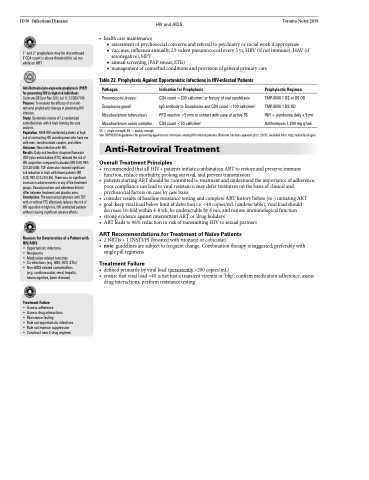Page 630 - TNFlipTest
P. 630
ID30 Infectious Diseases
HIV and AIDS Toronto Notes 2019
• healthcaremaintenance
■ assessment of psychosocial concerns and referral to psychiatry or social work if appropriate
■ vaccines: influenza annually, 23-valent pneumococcal every 5 yr, HBV (if not immune), HAV (if
seronegative), HPV
■ annual screening (PAP smear, STIs)
■ management of comorbid conditions and provision of general primary care
1° and 2° prophylaxis may be discontinued if CD4 count is above threshold for ≥6 mo while on ART
Anti-Retroviral pre-exposure prophylaxis (PrEP) for preventing HIV in high-risk individuals Cochrane DB Syst Rev 2012 Jul 11;7:CD007189 Purpose: To evaluate the efficacy of oral anti- retroviral prophylactic therapy in preventing HIV infection.
Study: Systematic review of 12 randomized controlled trials with 6 trials forming the core analysis.
Population: 9849 HIV-uninfected patients at high risk of contracting HIV including men who have sex with men, serodiscordant couples, and others. Outcome: New infection with HIV.
Results: Daily oral tenofovir disoproxil fumarate (TDF) plus emtricitabine (FTC) reduced the risk of HIV acquisition compared to placebo (RR 0.49; 95% CI 0.28-0.85). TDF alone also showed significant risk reduction in trials with fewer patients (RR 0.33; 95% CI 0.20-0.55). There was no significant increase in adverse events in any of the treatment groups. Sexual practices and adherence did not differ between treatment and placebo arms. Conclusions: Pre-exposure prophylaxis with TDF with or without FTC effectively reduces the risk of HIV aquisition in high risk, HIV uninfected patients without causing significant adverse effects.
Reasons for Deterioration of a Patient with HIV/AIDS
• Opportunistic infections
• Neoplasms
• Medication-related toxicities
• Co-infections (e.g. HBV, HCV, STIs)
• Non-AIDS-related comorbidities
(e.g. cardiovascular, renal, hepatic, neurocognitive, bone disease)
Treatment Failure
• Assess adherence
• Assess drug interactions
• Resistance testing
• Rule out opportunistic infections • Rule out marrow suppression
• Construct new 3-drug regimen
Table 22. Prophylaxis Against Opportunistic Infections in HIV-infected Patients
Pathogen
Pneumocystis jiroveci Toxoplasma gondii Mycobacterium tuberculosis Mycobacterium avium complex
Indication for Prophylaxis
CD4 count <200 cells/mm3 or history of oral candidiasis IgG antibody to Toxoplasma and CD4 count <100 cells/mm3 PPD reaction >5 mm or contact with case of active TB CD4 count <50 cells/mm3
Prophylactic Regimen
TMP-SMX 1 SS or DS OD TMP-SMX 1 DS OD
INH + pyridoxine daily x 9 mo Azithromycin 1,200 mg q1wk
SS = single strength; DS = double strength
See USPHS/IDSA guidelines for preventing opportunistic infections among HIV-infected persons (Relevant Sections updated 2013, 2015). Available from: http://aidsinfo.nih.gov/
Anti-Retroviral Treatment
Overall Treatment Principles
• recommendedthatallHIV+patientsinitiatecombinationARTtorestoreandpreserveimmune function, reduce morbidity, prolong survival, and prevent transmission
• patientsstartingARTshouldbecommittedtotreatmentandunderstandtheimportanceofadherence; poor compliance can lead to viral resistance; may defer treatment on the basis of clinical and psychosocial factors on case by case basis
• considerresultsofbaselineresistancetestingandcompleteARThistorybefore(re-)initiatingART
• goal:keepviralloadbelowlimitofdetectioni.e.<40copies/mL(undetectable);viralloadshould
decrease 10-fold within 4-8 wk, be undetectable by 6 mo, and restore immunological function
• strongevidenceagainstintermittentARTor‘drugholidays’
• ARTleadsto96%reductioninriskoftransmittingHIVtosexualpartners
ART Recommendations for Treatment of Naïve Patients
• 2NRTIs+1INSTI/PI(boostedwithritonavirorcobicistat)
• note:guidelinesaresubjecttofrequentchange.Combinationtherapyissuggested,preferablywith
single pill regimens
Treatment Failure
• definedprimarilybyviralload(persistently>200copies/mL)
• ensurethatviralload>40isnotjustatransientviremiaor‘blip’;confirmmedicationadherence,assess
drug interactions, perform resistance testing


